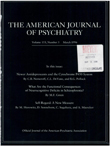DSM-III personality disorders in the community
Abstract
OBJECTIVE: The aims of this study were to estimate the prevalence and investigate the comorbidity and potential consequences of DSM-III personality disorders in the community. METHOD: A total of 810 adults were examined in the second stage of the Eastern Baltimore Mental Health Survey in 1981, part of the National Institute of Mental Health Epidemiologic Catchment Area program. The subjects were directly examined by psychiatrists using a semi-structured method that allowed diagnosis of all DSM-III personality disorders as well as other DSM-III psychiatric disorders. RESULTS: The prevalence of personality disorders in these adults was 5.9% (9.3% when provisional cases were included). Men had higher rates than women, and subjects who were separated or divorced had the highest rates. There was little comorbidity among specific personality disorders. Subjects with personality disorders were significantly more likely to have a history of sexual dysfunctions, alcohol use disorders, and drug use disorders as well as suicidal thoughts and attempts. In addition, they reported significantly more life events in the past year. Among subjects with any axis I disorder, those with personality disorders were judged by the psychiatrists to be more in need of treatment; however, only 21% were receiving treatment. CONCLUSIONS: Personality disorders are relatively common in the community. They are associated with axis I disorders and life events. Only one-fifth of the individuals who qualify for diagnoses of personality disorders in the community are receiving treatment.
Access content
To read the fulltext, please use one of the options below to sign in or purchase access.- Personal login
- Institutional Login
- Sign in via OpenAthens
- Register for access
-
Please login/register if you wish to pair your device and check access availability.
Not a subscriber?
PsychiatryOnline subscription options offer access to the DSM-5 library, books, journals, CME, and patient resources. This all-in-one virtual library provides psychiatrists and mental health professionals with key resources for diagnosis, treatment, research, and professional development.
Need more help? PsychiatryOnline Customer Service may be reached by emailing [email protected] or by calling 800-368-5777 (in the U.S.) or 703-907-7322 (outside the U.S.).



